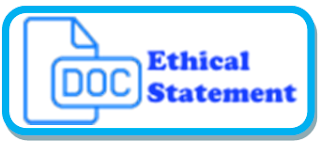Potensi dan Tantangan Naskah Kuno di Indonesia Sebagai Warisan Budaya Digital: Narrative Literature Review
Abstract
Indonesia has a diverse culture, history, and knowledge from the past written in ancient manuscripts. This research aims to identify the potential and challenges of ancient manuscripts in Indonesia, and formulate activities to overcome the challenges of ancient manuscripts as digital cultural heritage. The method used is Narrative Literature Review to explore and develop existing understanding and contribute to
shaping new perspectives. The data used was obtained from the Google Scholar database using research boundaries with a distance of the last 10 (ten) years, namely from 2014 - 2023 with a total of 8 journal articles. The data was analyzed by reducing and displaying data and making conclusions through a brief narrative. The results showed that ancient manuscripts in Indonesia have great potential as a source of information, history and knowledge, and can support the creative industry and tourism. However, there are challenges in the form of lack of public understanding, vulnerable physical condition of manuscripts, lack of public trust in the government, and threats from biological, physical, chemical, human, and natural disaster factors. In overcoming
these challenges, comprehensive efforts are needed such as socialization, additional budget, cooperation with various parties, increasing the capacity of human resources, and utilizing the latest technology in preserving ancient manuscripts. In conclusion,
the preservation of ancient manuscripts in Indonesia faces various complex challenges, but has great potential to be developed as a digital cultural heritage. Therefore, comprehensive efforts from various stakeholders are needed to overcome these challenges so that ancient manuscripts can be preserved and optimally utilized.
Keywords
Full Text:
PDF (Bahasa Indonesia)References
Badan Pengembangan dan Pembinaan Bahasa. “Kamus Besar Bahasa Indonesia (KBBI).” Kamus besar Bahasa Indonesia (KBBI), 2023. https://kbbi.kemdikbud.go.id/.
European Commission. “Digital Cultural Heritage.” Shaping Europe’s digital future, 2023. https://digital-strategy.ec.europa.eu/en/policies/culturalheritage.
Fatori, Muhkamad. “Konservasi Manuskrip Dalam Menjaga Warisan Nusantara Di Perpustakaan Pura Pakualaman Yogyakarta.” Manuskripta 9, no. 1 (2019): 85–96. https://doi.org/10.33656/manuskripta.v9i1.127.
Ford, Emily. “Tell Me Your Story: Narrative Inquiry in LIS Research.” College & Research Libraries 81, no. 2 (2020): 235–47. https://doi.org/10.5860/crl.81.2.235.
Hanum, Atiqa Nur Latifa, Antonius Totok Priyadi, Aliyah Nur’aini Hanum, and Aji Ali Akbar. “Peran Library, Archives, Museums Dalam Pelestarian Naskah Kuno Di Kalimantan Barat.” Berkala Ilmu Perpustakaan Dan Informasi 19, no. 1 (2023): 66–82. https://doi.org/10.22146/bip.v19i1.6294.
He, Y., Y. H. Ma, and X. R. Zhang. “‘Digital Heritage’ Theory and Innovative Practice.” In The International Archives of the Photogrammetry, Remote Sensing and Spatial Information Sciences, XLII-2/W5:335–42, 2017. https://doi.org/10.5194/isprs-archives-XLII-2-W5-335-2017.
Hendrawati, Tuty. “Digitalisasi Manuskrip Nusantara Sebagai Pelestari Intelektual Leluhur Bangsa.” Media Pustakawan 25, no. 4 (2018): 24–32. https://ejournal.perpusnas.go.id/mp/article/view/196.
Hermawan, Anton. “Sebuah Upaya Mempertahankan Identitas Nasional: Pelestarian Indegenous Knowledge Melalui Pengembangan Teknologi Pada Perpustakaan Nasional.” Pustabiblia: Journal of Library and Information Science 2, no. 2 (2018): 277–95. https://doi.org/10.18326/pustabiblia.v2i2.277-295.
Hidayani, Fika, and Am’mar Abdullah Arfan. “Meningkatkan Kecintaan Budaya Lokal Melalui Pelatihan Membaca Naskah Kuno Beraksara Pegon Di Kampus IAIN Syekh Nurjati Cirebon.” Yumary: Jurnal Pengabdian Kepada Masyarakat 3, no. 3 (2023): 183–89. https://doi.org/10.35912/yumary.v3i3.1815.
Indriani. “Perpusnas: 19.726 Naskah Kuno Di Indonesia Sudah Dilindungi.” ANTARA, 2023. https://www.antaranews.com/berita/3744981/perpusnas-19726-naskah-kuno-di-indonesia-sudah-dilindungi.
Laelasari, Eva. “Manajemen Pengelolaan Limbah Medis Rumah Tangga Era Pandemi Covid-19 Di Indonesia: Narrative Literature.” In Penelitian Dan Pengabdian Inovatif Pada Masa Pandemi Covid-19, 447–58. Jakarta: Prosiding Seminar Nasional Penelitian dan Pengabdian, 2021. https://prosiding.rcipublisher.org/index.php/prosiding/article/view/174.
National Library of Australia. “Guidelines for the Preservation of Digital Heritage.” UNESCO, 2003. https://unesdoc.unesco.org/ark:/48223/pf0000130071.
Novita, Nia, Haida Dafitri, and Nur Wulan. “Implementasi Algoritma Otsu Thresholding Dengan Median Filter Dalam Segmentasi Citra Digital Naskah Kuno Batak (Studi Kasus: Museum Negeri Provinsi Sumatera Utara).” Journal of Informatics and Data Science 1, no. 1 (2022): 7–9. https://doi.org/10.24114/j-ids.v1i1.24153.
Pramono, Pramono, Muchlis Awwali, Donny Eros, Rafiq Gusly Abdul Razaq, Surya Selfika, and Nur Ahmad Salman Herbowo. “Penerapan Naskah Kuno Dan Pemanfaatannya Untuk Pengembangan Wisata Religi Ziarah Di Surau Simaung Kabupaten Sijunjung.” Jurnal Warta Pengabdian Andalas 29, no. 4 (December 19, 2022): 488–96. https:// doi.org/10.25077/jwa.29.4.488-496.2022.
Ramadhan, Farhan Iswana Putra, and Prijana Prijana. “Kerjasama Preservasi Koleksi Langka Perpustakaan Pusat Survei Geologi Dengan Perpustakaan Nasional.” Pustabiblia: Journal of Library and Information Science 7, no. 2 (2024): 179–90. https://doi.org/10.18326/pustabiblia.v7i2.179-190.
Rasyid, Alvin. “Serat Ponco Driyo Digital Berbasis Android Untuk Meningkatkan Pengetahuan Masyarakat Tentang Naskah Kuno Dari Museum Ranggawarsita.” Universitas Dian Nuswantoro, 2015. http:// eprints.dinus.ac.id/15309/.
Ratmono, Damaji. “Strategi Akuisisi Naskah Di Perpustakaan Nasional Press Dalam Upaya Meningkatkan Bahan Bacaan Dan Literasi Masyarakat Indonesia.” Pustabiblia: Journal of Library and Information Science 6, no. 2 (2022): 257–76. https://doi.org/10.18326/pustabiblia.v6i2.257-276.
Rustiman, Uus, and Titin Nurhayati. “Naskah Kuno Arab Ath Thibbun Nabawi; Model Kebijakan Rasulullah SAW Dalam Ikhtiyar Menghadapi Wabah Karya Imam Adz Dzahabi Abad Ke-13.” Jurnal Al-Ibanah 5, no. 2 (2020): 1–19. https://journal.iaipibandung.ac.id/index.php/ibanah/article/view/37.
Saraswati, Ufi. “Arti Dan Fungsi Naskah Kuno Bagi Pengembangan Budaya Dan Karakter Bangsa Melalui Pengajaran Sejarah.” Sejarah UPI, 2017. https://sejarah.upi.edu/artikel/dosen/arti-dan-fungsi-naskahkuno-bagi-pengembangan-budaya-dan-karakter-bangsa-melaluipengajaran-sejarah/.
Suryaatmana, Emon, Undang Ahmad Darsa, Ane Erlyane, and Tiem Wartini. Paririmbon Sunda (Jawa Barat). Jakarta: Direktorat Jenderal Kebudayaan, 1992. UNESCO. “Charter on the Preservation of the Digital Heritage,” 2009. https://unesdoc.unesco.org/ark:/48223/pf0000179529.page=2.
Yuliani, Wiwin. “Metode Penelitian Deskriptif Kualitatif Dalam Perspektif Bimbingan Dan Konseling.” Quanta 2, no. 2 (2018): 83–91. https://ejournal.stkipsiliwangi.ac.id/index.php/quanta/article/view/1641.
DOI: https://doi.org/10.18326/pustabiblia.v8i1.1-17
Refbacks
- There are currently no refbacks.
Copyright (c) 2024 Pustabiblia: Journal of Library and Information Science

This work is licensed under a Creative Commons Attribution-NonCommercial-NoDerivatives 4.0 International License.
===========================================================================
Perpustakaan Institut Agama Islam Negeri (IAIN) Salatiga
Jl. Lingkar Salatiga Km. 2 Pulutan, Sidorejo,
Kota Salatiga, Jawa Tengah 50716,
Telp. (0298) 323706 – Fax. (0298) 323433
===========================================================================
Technical Support:Email : wiji.suwarno@gmail.com
Phone : +62 819-1433-5525



